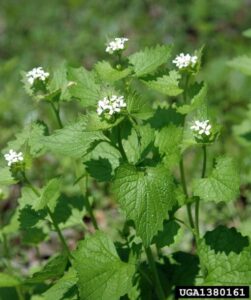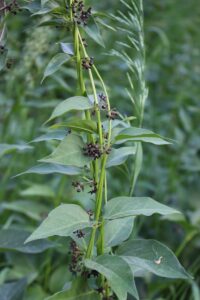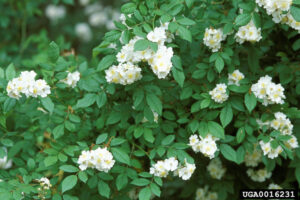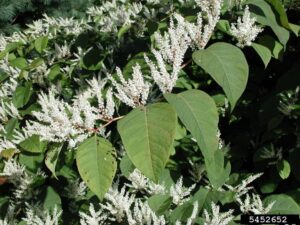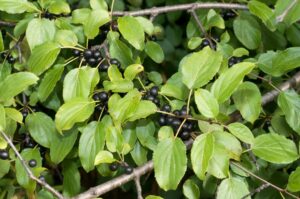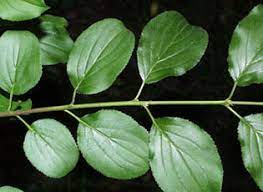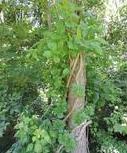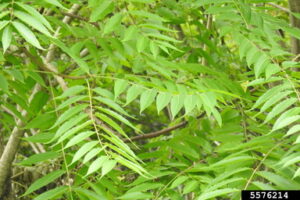Some species that are non-native to an ecosystem may become invasive: i.e., able to grow and spread rapidly, displacing native plants. Some were imported and grown intentionally in gardens; others may have reached our region by accident as seeds. But some that are especially adaptable to diverse conditions may escape gardens and, lacking their natural physical and biological controls on reproduction, may spread rapidly. By outcompeting native plants, such invasive species can cause loss of biodiversity and potentially cause economic or environmental harm or harm to human health.
Notably, non-native plants don’t serve the ecological roles of the natives they’ve displaced. For example, their flower nectar and/or pollen may not be accessible or not attractive to native pollinating insects; their fruit may not provide the nutritional value needed by insects or birds as they prepare for winter or migration; their foliage may be inedible by wildlife; their roots or their fallen leaves may disrupt soil organisms and soil health.
It is important that we recognize and remove invasive species that may be in our yards – so they don’t disrupt our gardens and to prevent their further spread in the neighborhood and beyond. Some of the currently most common invasive plants found in western New York are listed below. Visit Finger Lakes PRISM for more details about identifying and controlling the MANY regional invasive species. Note that PRISM (Partnership for Regional Invasive Species Management) works on all invasive species — aquatic and terrestrial, plants and animals. They also have opportunities to get involved in your community by helping to identify and even remove invasive plants.
Some common features to keep in mind:
- It’s always easier to remove (cut, pull out, dig out) those unwanted invaders when they are small. That usually means early in the season, but keep vigilant throughout your yard and throughout the season for best control.
- Many of these unwanted plants will vigorously regrow from cut stem or pieces of root! Hence, many mowings or cuttings may be needed to exhaust root reserves.
- Although we generally do not advocate using herbicides, in some cases this may be the most practical way to get rid of certain invasive plants. E.g., after cutting large shrubs or trees, dabbing herbicide around the outer edge of the cut surface (this is the living functional portion of the trunk) will kill the roots and should prevent regrowth. This very localized application avoids the general environmental contamination that occurs when using foliar spraying of herbicide.
- Remember that unwanted and invasive plants most often establish themselves in disturbed ground and/or where there is not much density of native growth. Once you’ve removed a patch of such unwelcome species, fill the void with some appropriate native species.
- Info here is very minimal. For more details to help with identification and removal, see cited websites [PRISM; invasive.org; others?].
- The species included below are (1) common in the Monroe County region, (2) are often found in yards and town parks, as well as roadsides, and other disturbed sites, and (3) are aggressive growers that can rapidly form dense stands and out-compete native plants.
|
Some Common Invasive Plants in Western New York State |
|||
|
Species name |
Description |
Removal |
|
|
Garlic mustard Alliaria petiolata |
•A biennial herbaceous • Pull out at either stage, |
• Tap root pulls out fairly easily if ground is not too dry (grab stem at ground level and pull gently) |
|
|
Swallow-wort Vincetoxicum spp. |
• Free-standing or twining up any nearby plant or structure, it can form dense stands that choke out most everything else. Shade-tolerant. • Small purplish flowers • Toxic to monarch caterpillars. |
• Roots are a bundle of white strands that are hard to pull out completely. Easiest when plant is small so be vigilant! • Can be dug out, but don’t put in compost pile. |
|
|
Multiflora rose Rosa multiflora |
• Long stems with sharp • Compound leaves; small white or pinkish flowers • Spreads by seed and roots and can form sprawling and climbing thickets |
• Wear gloves! Small plants can be pulled. • Large shrubs can be dug out (might want to cut stems first so base of plants can be safely reached). |
|
|
Japanese knotweed Reymoutria spp. |
• Thick hollow reddish • Can grow 10-15 ft tall and rapidly forms dense thickets • Spreads by seed and |
• If just a few stalks in your yard, dig and pull; roots can be VERY deep and long, so watch for re-sprouting. • Large patches may need herbicide: injection of stem is most effective [or let goats eat it!] |
|
|
Burning bush Euonymus alatus |
• Common landscape shrub that easily escapes, berries carried by birds. • Opposite dark green leaves; fall foliage is bright red • Lengthwise ridges on stems |
• Small plants can be |
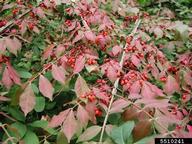 |
| Japanese barberry
Euonymus alatus
|
• Deciduous shade-tolerant shrub; thin straight spines on branches; small smooth-edged leaves • Red fall foliage and bright red elongated berries |
• Small shrubs can be uprooted, preferably before fruiting and easiest when ground is moist |
|
|
Common buckthorn Rhamnus cathartica |
• Medium sized or shrubby tree, often with multiple trunks • Oval leaves, prominent • Dark purple/blue berries • Deep fibrous roots consume and disrupt soil nutrient levels |
• cut stems/trunks will sprout vigorously • Small plants can be pulled if soil is not too wet/dry, or dug out • Mulch after removal to restore soil health |
|
|
Oriental bittersweet Celastrus orbiculatus |
• A woody vine that can coil tree trunk and strangle the tree • Orange/yellow berries • Glossy leaves |
• Small plants can be pulled from moist soil • Large stems (they can be 2-4″ diameter!) must be cut, treated |
|
|
Common reed Phragmites australis |
|
|
|
|
Tree of heaven Ailanthus altissima |
• Rapid-growing tree, smooth greenish bark; sprouts vigorously from roots or seed • Huge compound leaves smell offensive when crushed! • Attractive to invasive spotted lantern fly |
• Pull out small plants + roots before they establish • Larger saplings, trees must be cut, treated |
|
Photo acknowledgments: Garlic mustard - David Cappaert, bugwood.org Swallow-wort - Multiflora rose - James A. Miller, bugwood.org Knotweed - Leslie Mehrhoff, bugwood.org Burning bush - Leslie Mehrhoff, bugwood.org Barberry - Chris Evans, bugwood.org Buckthorn - Paul Wray, Iowa State Univ. Bittersweet - Richard Gardner, bugwood.com Tree-of-heaven - Richard Gardner, bugwood.com
